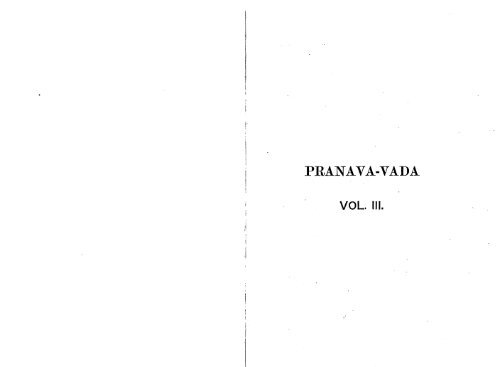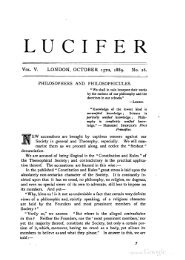PRANAVA-VADA
PRANAVA-VADA
PRANAVA-VADA
You also want an ePaper? Increase the reach of your titles
YUMPU automatically turns print PDFs into web optimized ePapers that Google loves.
<strong>PRANAVA</strong>-<strong>VADA</strong><br />
VOL. III.
THE SCIENCE OF THE SACRED WORD<br />
BEING A SUMMARISED TRANSLATION<br />
OF<br />
THE <strong>PRANAVA</strong>-<strong>VADA</strong><br />
OF<br />
GARGYAYANA<br />
BY<br />
BRAGA VAN DAS, M.A.<br />
with notes by Annie Besant<br />
VOL. III.<br />
Theosophical Publishing Bouse, Adyap, Kadras, India<br />
1913
SECTION III. (Oontinued.)<br />
CHAPTER XXVII.<br />
PARA AND APARA-PRAKJ.tTI.<br />
Light and shade as Para and A para-prakrti.<br />
JivatIria as the third.-The next stage of condensation<br />
as saHva, rajas and tamas; corresponding<br />
to ..A.tma-(orJivatma-) prakrti, ParaandApari<br />
respectively.-Endless repetitions of these and<br />
further and further condensatiolls.-M an a s, bU9-<br />
9hi, and ahailkara.-ChiHa, mahaHva and mamatva.-Thence<br />
three akash It s.-Thence three<br />
vayus, and so on.-Endless triplets, even denser<br />
than earth.-Other counts, by sevens, etc.-Formations<br />
of Il'toms by action and re-action.<br />
New facts and names arise out of this conjUllction<br />
of light and shade that was described<br />
in the preceding chapter. Light is Par ap<br />
l' a k r t j; shadow is A par ii.-p l' a k r P; the<br />
t picture' born of the two is the J i v it t m i1.<br />
Out of the conjunctions of this triplet of Par it,<br />
A par it 3.nd J i v it t m ii, arises the other triplet<br />
of sat t v a, r It j a s, and tam It s. The first is<br />
At m a-p l' It k r t i, i.e., the Self Itself (the<br />
possessor of the light); raj as is Pit l' a-p r a k r t i<br />
or prakaB.ha, light; tamas (darkness)<br />
is A pit r it-p l' a k r t i.1 In other words, the I is<br />
1 In the preceding chapter, A par a t m a was<br />
said to possess the quality of light and to reside
164<br />
PRA:tlAVA-VAVA.<br />
become," says the Brahma-Sft{1·a. And again:<br />
From one kind of expansive and contractive<br />
vibration, spa n g a and s p h u raJ). a, is born<br />
one (kind of substance). (In other words, the<br />
same root-matter, M 11 1 a-prakrti, in different<br />
kinds of vibrations, appears as different<br />
substances, with different sense-qualities).<br />
From the vibrations of r 11 p a, there is born<br />
taste, which can be felt only when visible shape<br />
is definitely present already.<br />
Finally, from the vibrations of taste, is born<br />
smell. In each one is included the 'experience'<br />
of another. (? Also, each one of the sensations<br />
of anyone sense has a specifically corresponding<br />
sensation belonging to each one of the other<br />
senses, e.g., sweet smell, sweet taste, sweet appearance,<br />
sweet touch, sweet sound). Medical<br />
science (in the department of Chemistry) tells<br />
us how such and such an odour may be produced<br />
out of such and such a taste belonging<br />
to such and such a substance.<br />
The sense-qualities belong to their respective<br />
substances and sense-organs, universally. (The<br />
same vibrations of the same atom will constitute<br />
the same substance, and will produce the<br />
same sensation in or on the receiving organs<br />
constituted in the same way, in any time and<br />
any space. In other words, given the same<br />
constitution of sense-organ, and of the vibrating<br />
,..<br />
LOVE AND HATE. 165<br />
atom, the resultant sensation experienced will<br />
be the same, in all times and all spaces).<br />
The well-known quintuplication, p a fi chi·<br />
k a r a Q a, l of the elements, has arisen in this<br />
wise. When the less known two other elements<br />
become manifest, then sap t i-k a r a l}. a or<br />
septuplication will be generally recognised.<br />
By the' conquest' of this sense-multiplication,<br />
this innate tendency to evolve new sense-qualities,<br />
substances, sense-organs, etc., 1 a y a is<br />
secured. 'Conquest' here means abolition, annihilation.<br />
It is true that complete annihilation<br />
of anything is not possible. Yet at the same<br />
time we see that I a y a is a constant and<br />
nnignorable fact also-in the way of inaction,<br />
sleep, by means of the Negation. It is ever<br />
present in the Logion. The condition between<br />
I and' This is I a y a, dissolution, reabsorptionl<br />
the point of neutrality wherein both factorS'<br />
become concealed. It is also the condition<br />
between This and Not, and between Not and I;<br />
1 In current Ver!anta works, this word means that<br />
at the present stage of our evolution these five<br />
elements exist for us united in a definite proportion,<br />
a moiety of each (giving the name) plus onequarter<br />
of the other half consisting of each of the<br />
other four. But here the word seems to mean<br />
simply the 'becoming or making five' of what<br />
was the one root-matter.
iv<br />
find it of some help in the culture and regulation of<br />
their emotional nature, the soundness and purity of<br />
which lie at the root of human welfare.<br />
The Indian Review, Madras, July, 1901.<br />
THE SCIENCE OF PEACE Rs. 4-8-0<br />
It The student should carefully study Bhaga.van<br />
Das' Science of Peace, in which the metaphysical<br />
questions involved are expounded with rare acumen<br />
and felicity."<br />
ANNIE BESANT (A Study in Oonsciousness, p. 6.)<br />
Writing a series of articles on the subject; in<br />
The Theosophist (1909), Mrs. Annie Besant said in a<br />
prefatory note; It These articles are an exposition<br />
of one of the most valuable books issued under<br />
the inspiration of 'I.'heosophy, The Science of Peace,<br />
by Bhagavan Das. Those who, seek a lasting intellectual<br />
foundation for their thinking will find<br />
much help from this valuable and original work."<br />
THE SCIENCE OF SOCIAL ORGANISATION·<br />
. ,<br />
OR THE LAWS OF MANU IN THE LIGHT<br />
OF THEOSOPHY Rs. 2-8-0.<br />
Popular edition 1-8-0.<br />
" Admirable Convention Lectures ..• A rare<br />
combination of deep learning and felicitous phrasing."<br />
ANNIE BESANT (Theosophy in India, 1910.)<br />
.. This book, like others from the same pen, has<br />
the indefinable quality of distinction: subtlety and<br />
v<br />
precision of thought, scholarly culture and urbanity<br />
of expression all mingling to. produce something<br />
eminently readable and provocative of re:H.ection.<br />
A great subject has been presented in a clear<br />
and pleasant way ... Weare shown, with .••<br />
admirable skill and lucidity, what J)harma meant<br />
to the age in which it was given. For those who<br />
look forward to a great revival of Indian spirituality,<br />
The Science of Social Organisation by Bhaga.van<br />
Das is rich in instruction ... An admirable·<br />
organon of the new idealism, which, though new in<br />
its hopes and aspirations, is yet reonian in its<br />
sources, and which, through the cyclic process of the<br />
Aryan race, must eventually bring back all the<br />
scattered members of that race to the level of<br />
thought and aspiration from which many thousands<br />
of yea.rs a.go, they started on their long journey ...<br />
... A book of the highest excellence and value.<br />
... A work which is clearly the outcome of long<br />
years of thonght and study, but which has also,<br />
just as clearly, been a labour of love."<br />
PROf!'. E. A. WODEHciuSE, M. A. (OXON.)<br />
(The O. H. O. Magazine, October, 1910.)<br />
"A revelation ... of the scientific principles which<br />
underlie our old social organisatiou ... It has been a<br />
delight and an instruction to read the work."<br />
MAHAMAHOPADHYAYA PAiwIT ADITYARAM BHATIA<br />
OHARTA, M. A., F. A. u., late Professor of Samskrt,<br />
Muir College, Allahabad.
PAGE LiNE FOR READ:<br />
220 11 Soheme, Soheme<br />
218 22 )<br />
222 25 If, SO, Hso,<br />
248 26 love love,<br />
"<br />
X<br />
14 Manifests Manifests,<br />
252 27 xiii., xiii.)<br />
253 29 where in wherein<br />
272 1 samiihara samiihiira<br />
355 27 Kundiilini KumJiilini<br />
361 25 prapbimbiis ••• prap bim b8.B<br />
27 sound Bound,<br />
"<br />
VOLUME III.<br />
PAGE LINE FOR READ:<br />
6 27 (of ohitta,) of ohitta,<br />
35 21 iva jiva<br />
38 19 bhriitrtvena bhriitrtvena.<br />
94. 29 ohohn




